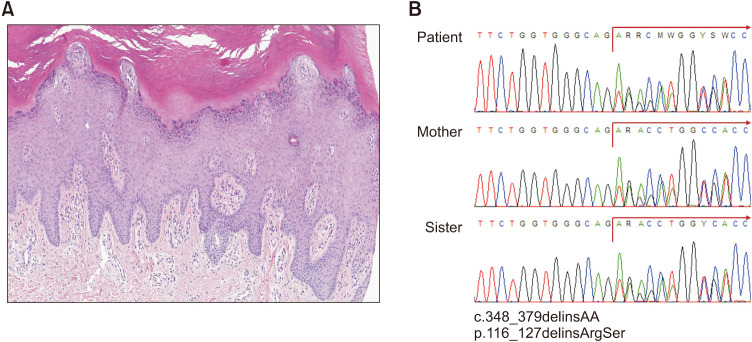先天性肿爪鱼KRT16基因的新变异,c.348_379delinsAA。
IF 1.5
4区 医学
Q3 DERMATOLOGY
引用次数: 0
摘要
本文章由计算机程序翻译,如有差异,请以英文原文为准。


Pachyonychia Congenita with a Novel Variant in the KRT16 Gene, c.348_379delinsAA.
Corresponding Author Je-Ho Mun Department of Dermatology, Seoul National University College of Medicine, 103 Daehak-ro, Jongno-gu, Seoul 03080, Korea Tel: +82-2-2072-3274, Fax: +82-2-742-7344, E-mail: jehomun@gmail.com https://orcid.org/0000-0002-0734-2850 *These authors have equally contributed to the article. Dear Editor: Pachyonychia congenita (PC) is a rare autosomal dominant keratinization disorder primarily affecting the skin and nails. PC is caused by dominant-negative mutations in one of five different keratin genes: KRT6A, KRT6B, KRT6C, KRT16, or KRT17. A Korean adolescent in his late 10s presented with painful plantar hyperkeratosis and nail changes. Due to plantar pain, he had difficulty in walking. His mother and sister had similar lesions. Physical examination revealed plantar keratoderma and dystrophic hyperkeratotic yellowish nails. Leukokeratosis of the oral mucosa was also observed (Fig. 1). A punch biopsy was obtained from his left sole (Fig. 2A). Microscopic examination of the sample showed marked acanthosis with hyperkeratosis, suggestive of palmoplantar keratoderma. We received the patient’s consent form about publishing all photographic materials. Blood sample was obtained to perform target gene sequencing using a next-generation sequencing panel. A novel likely pathogenic variant (PM1+PM2+PM4+PP1+PP3) in the KRT16 gene (NM_005557.3:c.348_379delinsAA) was
求助全文
通过发布文献求助,成功后即可免费获取论文全文。
去求助
来源期刊

Annals of Dermatology
医学-皮肤病学
CiteScore
1.60
自引率
6.20%
发文量
77
审稿时长
6-12 weeks
期刊介绍:
Annals of Dermatology (Ann Dermatol) is the official peer-reviewed publication of the Korean Dermatological Association and the Korean Society for Investigative Dermatology. Since 1989, Ann Dermatol has contributed as a platform for communicating the latest research outcome and recent trend of dermatology in Korea and all over the world.
Ann Dermatol seeks for ameliorated understanding of skin and skin-related disease for clinicians and researchers. Ann Dermatol deals with diverse skin-related topics from laboratory investigations to clinical outcomes and invites review articles, original articles, case reports, brief reports and items of correspondence. Ann Dermatol is interested in contributions from all countries in which good and advanced research is carried out. Ann Dermatol willingly recruits well-organized and significant manuscripts with proper scope throughout the world.
 求助内容:
求助内容: 应助结果提醒方式:
应助结果提醒方式:


